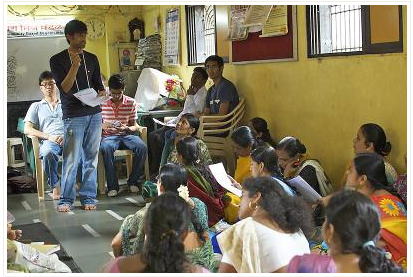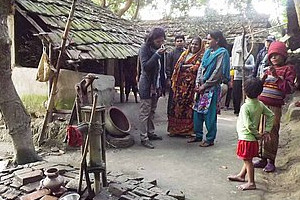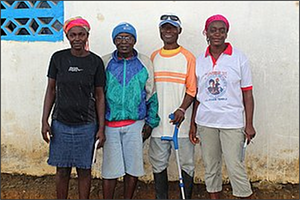Social Marketing

Social marketing is the use of commercial marketing techniques to promote the adoption of behaviour that will improve the health or well-being of the target audience or of society as a whole. Social marketing is not a stand-alone awareness raising tool; it's rather a framework or structure that combines classic promotional tools with knowledge from many other scientific fields to understand how to influence people’s behaviour.
Improving the current situation regarding sanitation and water in your area is very much connected with changing or adapting behaviours of the local community. By applying social marketing principles, you can positively influence current behaviours and therefore improve the well-being of the local community.
What Is Social Marketing?
Social Marketing is similar to conventional marketing, but the end goal is not to sell a product to make profits, but to achieve a social benefit (e.g. improvement of health, conservation of resources) for the society.
Social marketing is not a stand-alone awareness raising tool; is rather a framework or structure that combines classic promotional tools (see the other tools in awareness raising) with knowledge from many scientific fields such as economics, psychology, sociology, anthropology and communications theory to understand how to influence people’s behaviour. Social marketing is not easy to implement and involves changing intractable behaviours, in complex economic, social and political climates, often with very limited resources.
| Social marketing is the use of commercial marketing techniques to promote the adoption of behaviour that will improve the health or well-being of the target audience or of society as a whole. |
Some Fundamental Marketing Principles
The following marketing principles which are critical to the success of social marketing campaigns include:
- Understanding your AUDIENCE, their needs, wants, barriers and motivations.
- Being clear about what you want your audience to DO; changes in knowledge and attitudes are good if they lead to ACTION.
- Understanding the concept of EXCHANGE; you must offer your audience something very appealing in return for changing behaviour.
- Realising that COMPETITION always exists; your audience can always choose to do something else.
- Being aware of the “4 P’s of Marketing” and how they apply to your programme.
- Understanding the role that policies, rules and laws can play in efforts to affect social or behavioural change.
Marketing Mix – the 4 Ps

Marketing strategies are developed around the structure of the basic “4 Ps Framework” - product, price, place and promotion. An understanding of the 4 Ps allows the development of the appropriate product, at the right price, easily available through strategic sales placement, and known about through promotion, which also aims to enhance desire. Sometimes, also a 5th P (Policy) is used.
Product
The social marketing "product" is not necessarily a physical offering. A continuum of products exists, ranging from tangible, physical products (e.g. household latrines), to services (e.g. sludge removal service), practices (e.g. using proper toilets, saving water or recycling wastewater) and finally, more intangible ideas (e.g. environmental protection).
When the ‘product’ is behaviour, there may be associated physical products necessary to allow this behaviour change, e.g. new sanitation facilities which need to be considered here.
Before being able to design a product, the targeted "consumers" must have the awareness that they have a problem and that this can be addressed by a product (e.g. the product "household latrine" can address the problem "diarrhoea"). In particular in sanitation programmes, it is not easy to achieve this kind of awareness. A lot of demand creation needs to be done in cases, where cause and effect of products are not easily recognisable.
Price
Behaviour change itself may have no price tag. However, associated products (toilets, soap for hand washing, etc.) that make it easier can come at a price. These products need to be available at an affordable price to the target audience.
While the price is often an important contributor to the viability of a behaviour change programme, it is rarely the most important factor ruling product uptake as many assume, even when the very poor people are targeted. However, subsidies or incentives may be necessary in some cases to boost social marketing interventions.
Place
The products required for behaviour change need to be available and accessible in places for the target audience in order to make behaviour change truly possible. For example, the urban and rural poor need clean sanitation facilities nearby in order to change their open defecation practices. Or, people can only wash their hands with soap if they can buy soap in nearby stores, and if water is available. Especially with new technologies (e.g. urine-diversion dehydration toilets) this "P" tends to be very challenging as a whole new supply chain needs to be built.
Promotion
Having a product available in the right place, for the right price is the precondition to start with the promotion of your product. However when your "product" is a new behaviour or a social norm, promotion tends to be quite difficult. Awareness needs to be raised, and a desire to adopt the new behaviour created. This is done via promotion based upon an understanding of the motivations of the target audience and knowledge of their primary and trusted channels of communication (see also awareness raising).
The 5th P: Policy
In the case of social marketing programmes, a 5th "P" may be applied: policy. Policy can be used to make the unhealthy behaviour harder, for example through the banning of open defecation practices in public places (see also command and control tools), or by making the desired behaviour easier, by subsidising the provision of hand-washing facilities in schools for example (see also economic tools). An enabling policy or institutional environment can also be vital for sustaining behaviour change in the longer term.
Example of a Social Marketing Strategy
While the evidence for the effectiveness of traditional health promotion approaches is limited, social marketing may provide a fruitful alternative in the promotion of household environmental health. Indeed, the marketing approach to the promotion of hand-washing with soap is taking off internationally as indicated by the development of national and state-wide hand-wash marketing programmes (via public private partnerships) in Ghana, Peru, Senegal, South Africa, Indonesia, Madagascar, Nepal, and Ethiopia among others (see e.g. globalhandwashing.org).
The partnership is guided by the following principles:
- These deaths are preventable: Research shows that, if widely practised, hand-washing with soap could reduce diarrhoea by almost 50 % and respiratory infections by nearly 25% percent.
- Hand-washing with soap is a right: Every child has a right to vaccination and should also have the right to protection from hand-transmitted diseases.
- Large-scale changes in hand-washing practices can be achieved: A large-scale increase in the practice of hand-washing with soap would make a significant contribution to meeting the Millennium Development Goal 5: reducing deaths among children under five by two-thirds by 2015.
| To read more about Social Marketing: Social Marketing (DC) |
Field experiences
The following projects utilize social marketing methods.
 Coastal area Water, Sanitation and Hygiene |
 Introducing 3R in impact areas of DWA |
 Accelerating Sanitation and Water for All 1 |
 Basic Sanitation for Loja Province |
Other social marketing links
- Thesis Dirk Jaap Stuurman, Msc. The Influence of Social Marketing on Adoption of Social Innovations: A Dyadic Study on Ceramic Pot Filters. Practica Foundation.
- RIETBERGEN-McCRACKEN, J.; NARAYAN, D. ; WORLD BANK (Editor) (1998): Participation and Social Assessment: Tools and Techniques. Washington: World Bank. URL [Accessed: 10.05.2010]. PDF
- This resource kit aims to share information and experiences on participatory methods in the context of development cooperation. The primary focus concentrates on providing practical guidance and case examples.
- MACFADYEN, L.; STEAD, M.; HASTINGS, G. (1999): A Synopsis of Social Marketing. Stirling: Institute for Social Marketing. URL [Accessed: 03.09.2010]. PDF
- This paper gives a good overview of social marketing and explains its development and contains different definitions.
- NATIONAL EXCELLENCE COLLABORATIVE (Editor) (n.y.): The Manager’s Guide to Social Marketing. Using Marketing to Improve Health Outcomes from the Social Marketing. Accessed: 03.09.2010. Alternative link: PDF. This handbook describes the different phases of implementing social marketing and explains how to handle finances and budgets related to social marketing.
- SCOTT, B. (2005): Social Marketing: A Consumer-based Approach to Promoting Safe Hygiene Behaviours. Leicestershire: WELL. URL [Accessed: 03.09.2010]. PDF
- This is a good website which gives a comprehensive understanding about social marketing.
Acknowledgements
- Stefanie Keller, Michael Kropac. SUSTAINABLE SANITATION AND WATER MANAGEMENT. Social Marketing (DC)

